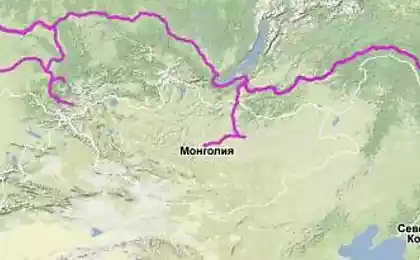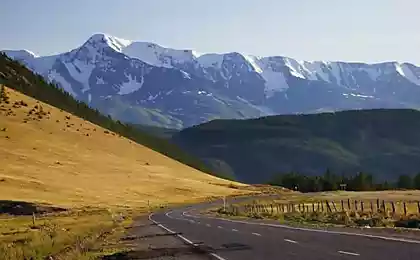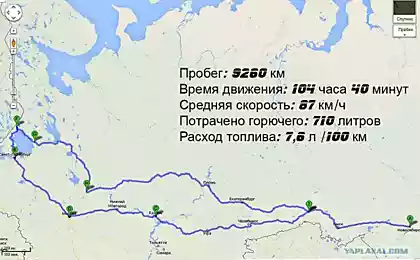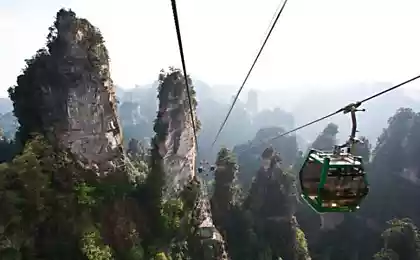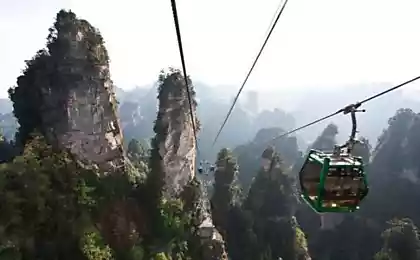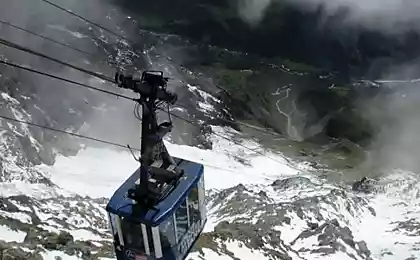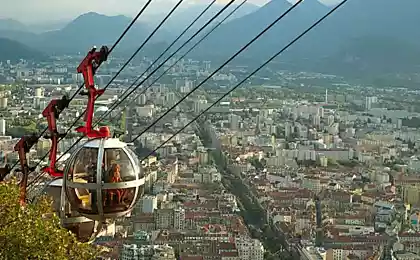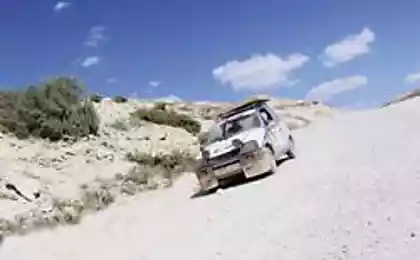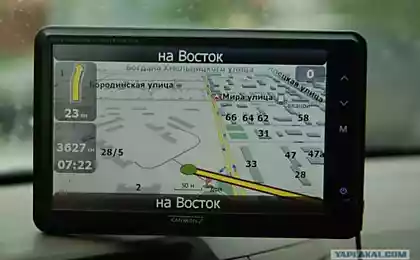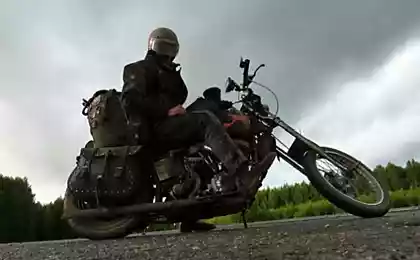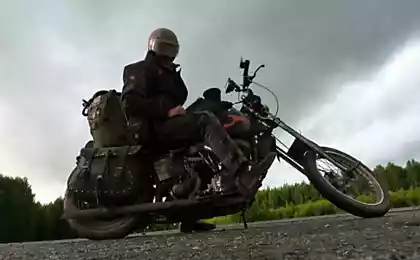524
The way of the future. Why spring is eroding the asphalt and how to avoid it
Every spring the residents of the most Russian cities remember the full range of known swear words. The reason the road: they literally overnight, transformed from turbulent rivers to ice-rinks, and asphalt with them coming off together with snow. Are there any roads that do to the mind? It turns out that Yes, there are. At least there are attempts to create them.
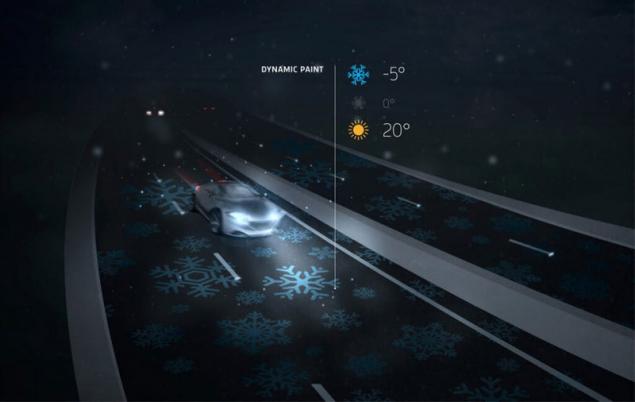
The path of ice and fire
For Russia, of course, the issue of ice on the roads, rather than boiling asphalt. On the eve of 8 March 2017 in hospital in Moscow, addressed more than 65 people who were injured because of the ice. And here in the US are seriously concerned about the too high temperature of the road surface in the Western States of America good 35 seconds of direct contact of human skin with the asphalt on a hot day – and a second-degree burn is guaranteed.
The main danger in that and in other case – it is the carelessness of drivers and pedestrians. However, there is a single solution: clever "dynamic paint" on a road by Studio Roosegaarde. It works like this: when the temperature on the road begin to show white and blue snowflakes, they warn drivers of possible ice on the road. But if the asphalt begins to melt, aktiviziruyutsya drawings of the sun. Such inks are already used for summer children's clothing that parents could understand, when the child gets too hot. Now, since "pridenet" roads: pilot phase with dynamic colors should appear on the Dutch highway 66 in the province of Brabant.
But still paint with the icing doesn't fight, she just warns drivers of the danger. With icy conditions while fighting in several ways: shot down the ice by hand or using special equipment, sprinkle roadways and sidewalks with sand or special reagents containing chlorides.
However, has created the road on which ice cannot form. Nanotechnological superhydrophobic surface created by scientists from Harvard. Water from it just bounces. And no water – no ice. Armed with innovation, the city of Crandon (Wisconsin, USA) have made some of their roads are hydrophobic.
Another idea: roads that are not afraid and love the water. So that drink it with cubic meters. And Yes, such a coating actually exists, it's called Topmix Permeable. This material is so porous, holds water in the soil layers just like a sponge. Watch the video, it's impressive: 4000 litres of water per minute, and Parking – though henna, it is completely dry. It is assumed that on the surface of puddles may not be at all. Several roads and Parking lots in England dressed in Topmix Permeable.
Darkness falls
The same guys that suggested the use of dynamic paint on the roads, has put forward one more idea: use for marking on the intercity highway a fluorescent dye. They have developed a glowing powder that can be added to the usual mixture for marking without changing its other properties. Day markup "charged" by the sun, and the night glows up to 10 hours in a row.
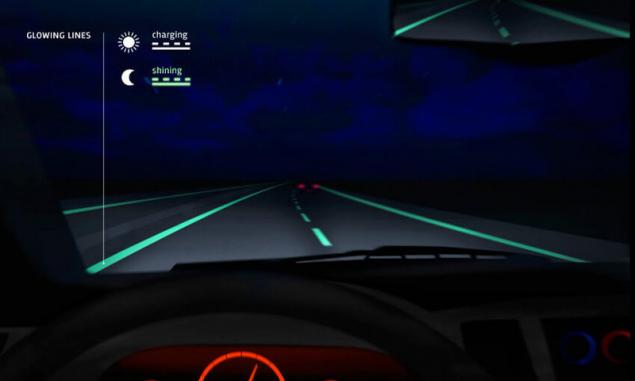
It is the same in Holland. Such "colorful" idea is a relatively simple way to make the roads much safer. Fluorescent tagging is a simple way to save on electricity for lighting the trails. And why didn't anyone think of this before? Although new to Russia may not be particularly relevant: the majority of intercity roads do not have markings.
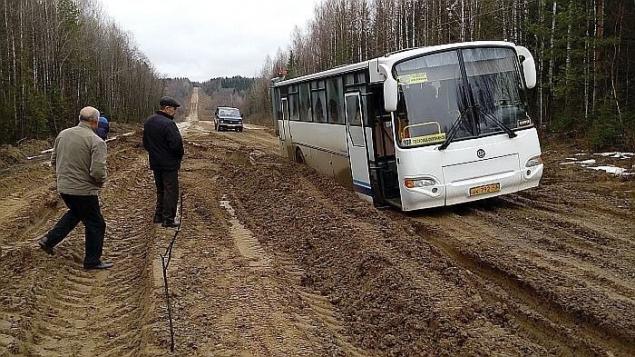
The energy of the road
Speaking of electricity, I want to tell you about a few projects that transform highways into power plants.
First – about the project the Israeli company Innowattech. It is based on piezoelectric generators underneath a layer of asphalt. They convert the kinetic energy of the pressure from the wheels of cars into electric current. Performance – 200 kilowatts per hour of "work". Experienced a stretch of road "piezoelectrically" in Israel in 2009. 7 years later, in 2016, the same "green" roads started in California (USA).
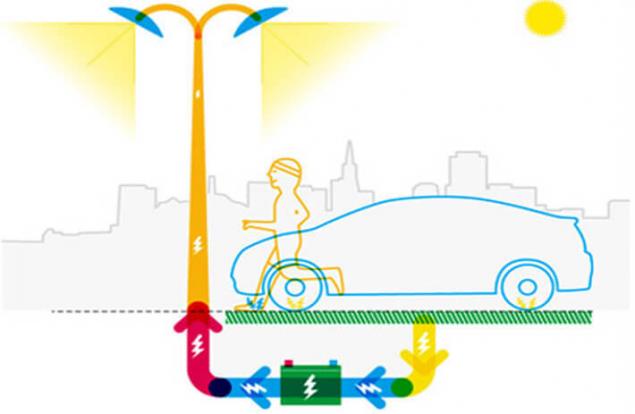
The second project is a Dutch mini-wind turbines along the highway, all from the same brilliant developers from the Studio Roosegaarde. They are small, but a lot of them. According to the developers, this should be enough for lighting of highways.
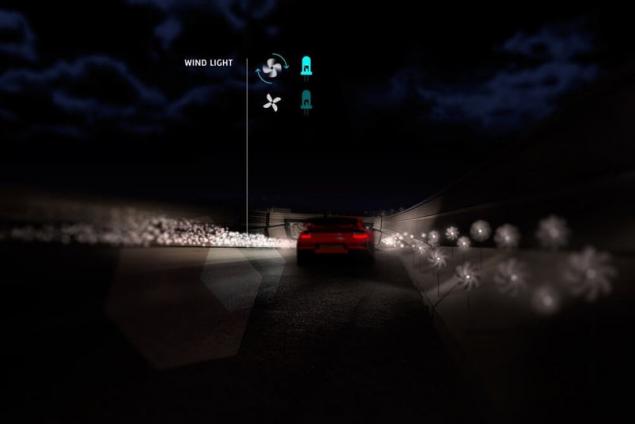
Finally, the Champions of the project Solar Roadways. It was created by a husband and wife from Idaho. The whole point in solar batteries under the bulletproof glass that can withstand a weight of 1000 tons. Of these developers propose to build roads. In hexagonal solar panels embedded LEDs, and this means that the roads of them can have an interactive luminous markings. And Yes, the temperature is always above 0, which means that any snow and ice under the wheels. According to the creators of Solar Roadways, if re-equip the entire road grid of the U.S. such panels, there are no other energy sources do not need: Sunny slopes will produce 3 times more electricity than now consumes US. Produced same panel, Solar Roadways from recycled glass and plastic.
Second life
"Green" always complain that no asphalt road is not without products of oil refining: it is the bitumen that holds part of the weight of the asphalt. Attempt something this bitumen to replace were made for a long time, but did not bring much success: the asphalt that crumbles, then spread (by the way, experiments with the composition of the bituminous mixtures is one of the favorite pastimes of the Russian road).
But here's what actually worked – so it's "asphalt rubber" from old tires. In this the bitumen was replaced by crumb rubber from shredded tires. The coating is quiet and durable – the joy of "green". Such roads already constructed in California, Arizona and Florida. In Russia there were attempts to adopt this technology, but that didn't go well.

What else can be recycled in the road? Bottle plastic from the oceans. The idea of the Plastic Road project came from the Dutch company Royal VolkerWessels. So, waste is melted in a cast plate, which are connected to each other butt joint. Multilayer complex bases, such as, for asphalt, they do not need a plastic way, a conventional sand bags. Inside the panel is hollow, and therefore, they can pave all city communications – this time, and have storm sewers – two, to equip the heating elements from glaciation is three. Temperature changes the plastic road is not terrible: it successfully copes with the load and at -40 degrees Celsius and +80 degrees. Wins plastic conventional coatings and in life: the authors of the project promise is 2-3 times greater durability. As to repair "worn" sections of the road will be 70% faster. published
P. S. And remember, only by changing their consumption — together we change the world! ©
Source: futurist.ru/articles/847-doroga-v-budushchee-pochemu-vesnoy-razmivaet-asfalyt-i-kak-etogo-izbezhaty

The path of ice and fire
For Russia, of course, the issue of ice on the roads, rather than boiling asphalt. On the eve of 8 March 2017 in hospital in Moscow, addressed more than 65 people who were injured because of the ice. And here in the US are seriously concerned about the too high temperature of the road surface in the Western States of America good 35 seconds of direct contact of human skin with the asphalt on a hot day – and a second-degree burn is guaranteed.
The main danger in that and in other case – it is the carelessness of drivers and pedestrians. However, there is a single solution: clever "dynamic paint" on a road by Studio Roosegaarde. It works like this: when the temperature on the road begin to show white and blue snowflakes, they warn drivers of possible ice on the road. But if the asphalt begins to melt, aktiviziruyutsya drawings of the sun. Such inks are already used for summer children's clothing that parents could understand, when the child gets too hot. Now, since "pridenet" roads: pilot phase with dynamic colors should appear on the Dutch highway 66 in the province of Brabant.
But still paint with the icing doesn't fight, she just warns drivers of the danger. With icy conditions while fighting in several ways: shot down the ice by hand or using special equipment, sprinkle roadways and sidewalks with sand or special reagents containing chlorides.
However, has created the road on which ice cannot form. Nanotechnological superhydrophobic surface created by scientists from Harvard. Water from it just bounces. And no water – no ice. Armed with innovation, the city of Crandon (Wisconsin, USA) have made some of their roads are hydrophobic.
Another idea: roads that are not afraid and love the water. So that drink it with cubic meters. And Yes, such a coating actually exists, it's called Topmix Permeable. This material is so porous, holds water in the soil layers just like a sponge. Watch the video, it's impressive: 4000 litres of water per minute, and Parking – though henna, it is completely dry. It is assumed that on the surface of puddles may not be at all. Several roads and Parking lots in England dressed in Topmix Permeable.
Darkness falls
The same guys that suggested the use of dynamic paint on the roads, has put forward one more idea: use for marking on the intercity highway a fluorescent dye. They have developed a glowing powder that can be added to the usual mixture for marking without changing its other properties. Day markup "charged" by the sun, and the night glows up to 10 hours in a row.

It is the same in Holland. Such "colorful" idea is a relatively simple way to make the roads much safer. Fluorescent tagging is a simple way to save on electricity for lighting the trails. And why didn't anyone think of this before? Although new to Russia may not be particularly relevant: the majority of intercity roads do not have markings.

The energy of the road
Speaking of electricity, I want to tell you about a few projects that transform highways into power plants.
First – about the project the Israeli company Innowattech. It is based on piezoelectric generators underneath a layer of asphalt. They convert the kinetic energy of the pressure from the wheels of cars into electric current. Performance – 200 kilowatts per hour of "work". Experienced a stretch of road "piezoelectrically" in Israel in 2009. 7 years later, in 2016, the same "green" roads started in California (USA).

The second project is a Dutch mini-wind turbines along the highway, all from the same brilliant developers from the Studio Roosegaarde. They are small, but a lot of them. According to the developers, this should be enough for lighting of highways.

Finally, the Champions of the project Solar Roadways. It was created by a husband and wife from Idaho. The whole point in solar batteries under the bulletproof glass that can withstand a weight of 1000 tons. Of these developers propose to build roads. In hexagonal solar panels embedded LEDs, and this means that the roads of them can have an interactive luminous markings. And Yes, the temperature is always above 0, which means that any snow and ice under the wheels. According to the creators of Solar Roadways, if re-equip the entire road grid of the U.S. such panels, there are no other energy sources do not need: Sunny slopes will produce 3 times more electricity than now consumes US. Produced same panel, Solar Roadways from recycled glass and plastic.
Second life
"Green" always complain that no asphalt road is not without products of oil refining: it is the bitumen that holds part of the weight of the asphalt. Attempt something this bitumen to replace were made for a long time, but did not bring much success: the asphalt that crumbles, then spread (by the way, experiments with the composition of the bituminous mixtures is one of the favorite pastimes of the Russian road).
But here's what actually worked – so it's "asphalt rubber" from old tires. In this the bitumen was replaced by crumb rubber from shredded tires. The coating is quiet and durable – the joy of "green". Such roads already constructed in California, Arizona and Florida. In Russia there were attempts to adopt this technology, but that didn't go well.

What else can be recycled in the road? Bottle plastic from the oceans. The idea of the Plastic Road project came from the Dutch company Royal VolkerWessels. So, waste is melted in a cast plate, which are connected to each other butt joint. Multilayer complex bases, such as, for asphalt, they do not need a plastic way, a conventional sand bags. Inside the panel is hollow, and therefore, they can pave all city communications – this time, and have storm sewers – two, to equip the heating elements from glaciation is three. Temperature changes the plastic road is not terrible: it successfully copes with the load and at -40 degrees Celsius and +80 degrees. Wins plastic conventional coatings and in life: the authors of the project promise is 2-3 times greater durability. As to repair "worn" sections of the road will be 70% faster. published
P. S. And remember, only by changing their consumption — together we change the world! ©
Source: futurist.ru/articles/847-doroga-v-budushchee-pochemu-vesnoy-razmivaet-asfalyt-i-kak-etogo-izbezhaty
5 healing drinks that heal urinary tract infection
Tested Jaguar sports crossover I-PACE on the roads of London
